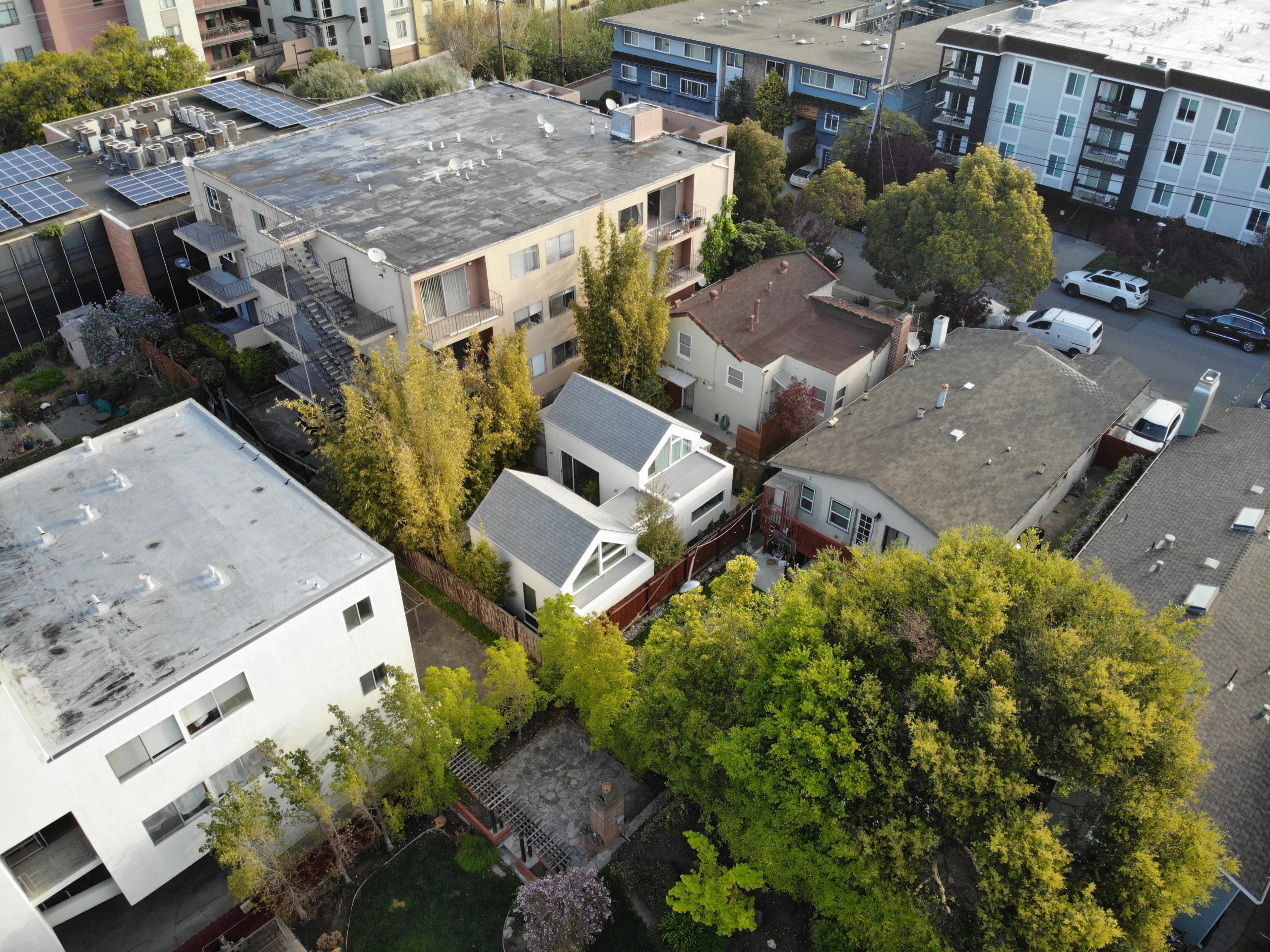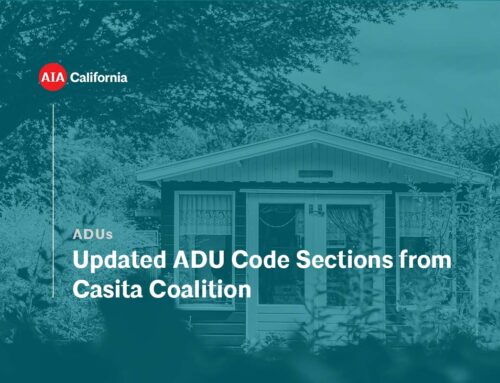Honor Award //project details Architect: 3R Studio Project Location: Albany, CA Photographer: Bruce Damonte By breaking the conventional form into smaller volumes, the urban infill structure serves as a boundary
The post Evelyn ADU appeared first on AIA California.
Evelyn ADU
//project details
Architect: 3R Studio
Project Location: Albany, CA
Photographer: Bruce Damonte
By breaking the conventional form into smaller volumes, the urban infill structure serves as a boundary that defines private outdoor spaces and buffer zones. Each volume can function independently as work or living areas, or collectively with the garden for social events. Rooms intimately connect to the outdoors, benefitting from light and air while being screened by greenery and the building itself. By embracing adaptable boundaries, the accessory dwelling unit accommodates diverse uses with a minimal footprint of 630 sf. The multipurpose room flexibly transforms into a meditation area, yoga space, living room, or office meeting point. The bridge can open to create an outdoor dining/meeting zone, and the lofts function as a library and a guest room. The project leverages the site’s offerings to enable two families to live and work on a 3,750 sf property originally designed for a single home. The living spaces are compact yet highly efficient, conserving cost and energy.
//comments
Beautifully designed and a great example of an elegant approach to designing an ADU. | A good job of providing density in a different way than we see in ADUs. | A very clear and reductive ADU with quite high performance.
//framework for design excellence measures
Measure 1: Design for Integration
By breaking the conventional form into smaller volumes, the urban infill structure serves as a boundary that defines private outdoor spaces and buffer zones. Each volume can function independently as work or living areas, or collectively with the garden for social events. Rooms intimately connect to the outdoors, benefitting from light and air while being screened by greenery and the building itself. By embracing adaptable boundaries, the house accommodates diverse uses with minimal footprint. The multipurpose room flexibly transforms into a meditation area, yoga space, living room, or office meeting point. The bridge can open to create an outdoor dining/meeting zone, and the lofts function as a library and a guest room.
Measure 2: Design for Equitable Communities
The project has a highly convenient location adjacent to all public amenities, a mere 5-minute walk to the Bart/train station. Commuting without a car is the norm, as kids are accompanied on foot to school, and a Transbay bus or Bart train serves the city for the parents commute. Bike lanes are frequently utilized, and each house is equipped with designated bike storage spaces.
Measure 3: Design for Ecosystems
The building shape creates several micro zones accommodating a variety of vegetation. The building orientation, its low eaves and the short bridge allow sunlight to reach the gardens even during winter. The entire outdoor area features permeable surfaces, including grating walkways and patios.
During the construction process, a non-native eucalyptus was removed to reduce the fire hazard. Several trees and plants were saved and replanted. The original lawn was transformed into gardens with native plants inviting birds and insects.
Measure 4: Design for Water
The entire outdoor area features permeable surfaces, including grating walkways and patios. The original lawn has been replaced with native plants and drought-resistant groundcover, significantly reducing water usage for irrigation. The landscape is carefully zoned and irrigated by a smart controller to prevent excessed irrigation. Communicating with the weather station, the controller conserve water in the event of rain and seasonal changes.
Measure 5: Design for Economy
The cost per square foot does not factor in the 314 square foot of lofts spaces. Despite being designated as unhabitable due to its peak ceiling at 7’, the lofts serve as guest room, storage and library. Owners installed Ikea cabinet modules and fiberglass grating, economizing. The multipurpose room transitions from meditation hall to yoga studio, office, and living room. The bridge/foyer expands for dining. Loft ladders save space and cost. Strategic window placement offers ventilation, daylight, and views, reducing material needs. Prioritizing longevity, straightforward design, inexpensive materials, existing landscape preservation, and energy-efficient technology harmonize for cost-effective excellence.
Measure 6: Design for Energy
Highly insulated walls and R-60 roofs reduce heating requirement. Low-e south facing glass with awning improves solar gain in winter months while blocking some summer sun. ERV and radiant floor heating improves comfort and indoor air quality during winter. Low windows on the north and high windows on the south enhance natural ventilation during summer. With cool roof, the ADU does not need air conditioner. A solar system is in the work to offset 95% of electric use. Compact appliances with energy saving technologies such as induction cooktop and heat pump dryer further reduce energy consumption.
Measure 7: Design for Well-Being
Upon entering the ADU, visitors often express surprise. Situated amidst urban density, it’s a backyard retreat—a serene oasis in a bustling urban context. Natural light and seamless indoor-outdoor connections take precedence, fostering tranquility. All rooms overlooking a garden, including room with double-height space, provides a uplifting and adaptable space that can accommodate various needs and preferences. Strategic windows ensure glare prevention, ventilation, ample daylight, outdoor views, while maintaining privacy. Floor-to-ceiling and loft windows amplify daylight. The ADU remains well-lit without artificial lighting year-round. Utilizing ERV and radiant floor heating enhances indoor air quality, comfort, and winter heat retention.
Measure 8: Design for Resources
The materials were selected for their long durability and locally accessibility. Foundation formwork was reused to frame roof rafters. The contractor skillfully constructed the shower floor, salvaging remnants of IPE wood decking from their previous project. The demolished shed framing materials were reused in landscape retaining walls.
Our approach prioritizes what truly matters over-accumulating details or decorative features. With an eye on longevity, a straightforward form, conventional robust materials, and updated energy-efficient technologies harmonize. This holistic approach underscores our commitment to lasting, eco-conscious design, reflecting the principles of Design for Resources.
Measure 9: Design for Change
A family with two kids is renting the front house and we moved to the ADU. This living arrangement fosters a warm co-housing dynamic, allowing us to frequently share food and baked treats. The boys in kindergarten age have the pleasure of their own yard for out-door games and sometimes surprise us with flowers and goodies to brighten our days. Both families effectively operate their home offices, ensuring seamless work-from-home dynamics. Privacy remains intact, courtesy of layers of threshold spaces within landscape and buildings. Solar panels will provide energy to both houses, with the shared car charger serving both residences.
Measure 10: Design for Discovery
We have learnt to move away from the noise of over-accumulating details or decorative objects, and embrace a life of contentment with less. This process of letting go and refining allows us to design for simplicity and prioritizes what truly matters. Instead of more attention-seeking features, our focus lies in crafting designs that invite tranquility through unburdened spaces.
The house came to life under the hands of a small crew of two builders. Collaborating with this experienced and thoughtful team was a true blessing, as we jointly devised the most efficient and effective methods to put things together.
The post Evelyn ADU appeared first on AIA California.
AIA CaliforniaRead More





